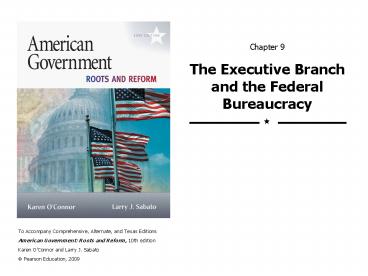Chapter 9 The Executive Branch and the Federal Bureaucracy PowerPoint PPT Presentation
1 / 19
Title: Chapter 9 The Executive Branch and the Federal Bureaucracy
1
Chapter 9The Executive Branch and the Federal
Bureaucracy
?
To Accompany Comprehensive, Alternate, and Texas
Editions American Government Roots and Reform,
10th edition Karen OConnor and Larry J. Sabato ?
Pearson Education, 2009
2
The Roots of Bureaucracy
- Foreign Affairs, War, Treasury first
departments. - Growth in early 1800s with Post Office.
- Patronage and the spoils system become common.
- Civil War spawns another expansion.
- Pendleton Act is beginning of civil service
system. - Also known as merit system.
- Creation of independent regulatory commissions.
3
Twentieth-Century Bureaucracy
- Growing number of cabinet departments.
- Need for a larger government to support wars.
- New Deal and Great Society.
4
Modern Bureaucracy
- More than 2.7 million employees.
- Most are selected based on merit.
- Also have high-level appointees.
- Wide variety of skills represented.
- Less diverse than America.
- Scattered throughout D.C. and regional offices.
- Growth of outside contractors.
5
Formal Organization
- Cabinet departments handle broad, lasting
issues. - Headed by secretaries.
- Government corporations act like businesses.
- Independent executive agencies handle services.
- Narrower than Cabinet department, independent.
- Independent regulatory commissions watch
industry. - Designed to be free from partisan pressure.
6
Government Workers and Politics
- Hatch Act sets first boundaries.
- Federal Employees Political Act is current
standard.
7
Characteristics of Bureaucracy
- Chain of command from top to bottom.
- Division of labor.
- Clear lines of authority.
- Goal orientation.
- Merit system.
- Productivity.
8
How the Bureaucracy Works
- Congress creates agencies.
- Main job is implementation of laws.
- Policy made in iron triangles or issue networks.
- Increasing use of interagency councils.
9
Making Policy
- Administrative discretion allows a lot of
latitude. - Rule-making is a quasi-legislative process.
- Formal procedure for making regulations.
- Administrative adjudication is quasi-judicial
process. - Used to settle disputes between two parties.
10
Agency Accountability
- Unclear who agencies should be accountable to.
- Presidents try to make the right appointments.
- Can also shape policy through executive orders.
- Congress can use oversight powers and funding.
- Police patrol v. fire alarm oversight.
- Judiciary can review regulations.
11
AV- Growth of Government
?
Back
12
Figure 9.1- Civilian Employment
?
Back
13
Figure 9.2- Employee Characteristics
?
Back
14
Figure 9.3- Agency Regions
?
Back
15
Figure 9.4- The Executive Branch
?
Back
16
Figure 9.5- An Iron Triangle
?
Back
17
Figure 9.6- Rulemaking
?
Back
18
Table 9.1- FEPA
?
Back
19
Table 9.2- Agency Accountability
?
Back

